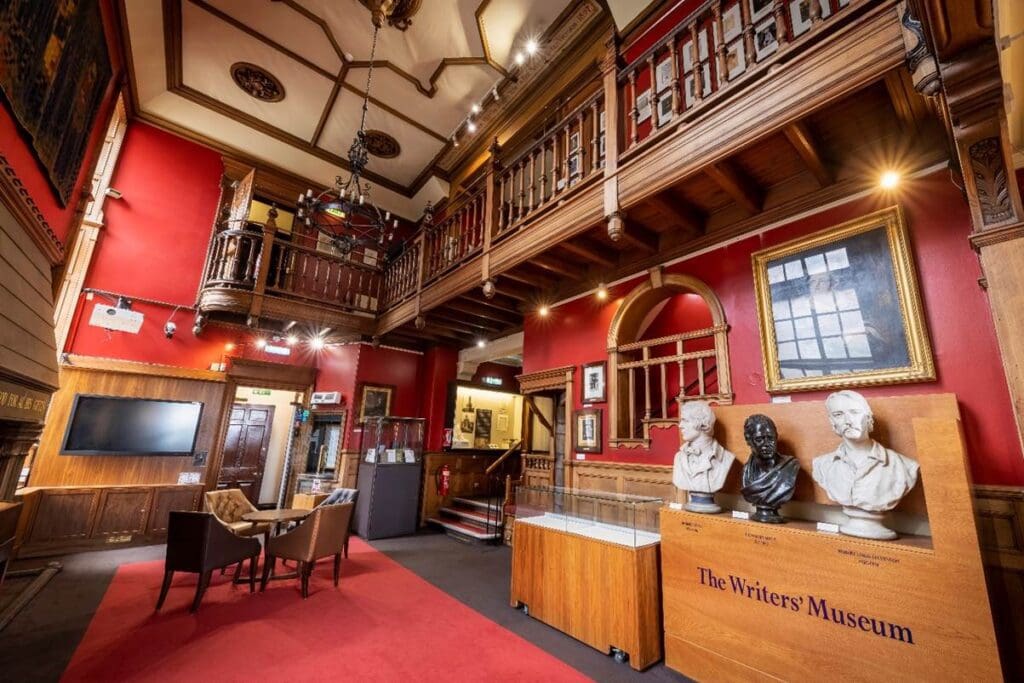With its cobbled closes, shadowy stairways, and skyline stitched with spires, Edinburgh is a city that feels like it was written before it was built. It’s no surprise, then, that this atmospheric capital has inspired generations of writers and become a UNESCO City of Literature—the first in the world. From Enlightenment-era philosophers to modern fantasy giants, the city hums with literary spirit. For lovers of the written word, here are some unmissable spots to explore in Edinburgh’s rich literary landscape.
Book a Private Tour with us and you can see all of these locations. Just put ‘Literary Tour’ in the comments box on our booking form.

Tucked away off the Royal Mile in Lady Stair’s Close, the Writers’ Museum is a quiet homage to three of Scotland’s literary titans: Robert Burns, Sir Walter Scott, and Robert Louis Stevenson. Manuscripts, portraits, and personal items like Scott’s rocking chair or Stevenson’s snuff box bring these legendary figures to life. It’s a small museum, but it packs a poetic punch.
Tip: Entry is free, and the winding stairs and old-world interiors feel like stepping into a novel themselves.

Standing tall in Princes Street Gardens, the Scott Monument is an unmistakable gothic rocket to the sky. Built to honour Sir Walter Scott, the 19th-century novelist who helped define Scottish identity, it’s one of the largest monuments to a writer anywhere in the world. Climb the 287 steps for panoramic views of the city, and pause halfway to admire the statues of characters from his novels.
Scott’s historical fiction, particularly Waverley, Rob Roy, and The Heart of Midlothian, helped put Scotland on the literary map. Even if you haven’t read his works, the monument is a stirring tribute to Edinburgh’s literary pride.
3. Makars’ Court
Just outside the Writers’ Museum, you’ll find Makars’ Court, a quiet, cobbled space that celebrates Scotland’s literary “makars” (poets or wordsmiths). Quotations from writers such as Muriel Spark, Hugh MacDiarmid, and Liz Lochhead are etched into the stones underfoot. It’s a lovely place to reflect on the power of language—and perhaps snap a photo of your favourite quote.
4. Edinburgh Central Library

Opened in 1890 with funding from Andrew Carnegie, Edinburgh Central Library on George IV Bridge is a Victorian jewel. The grand reading rooms, Art Nouveau flourishes, and stained-glass windows make it one of the city’s most beautiful indoor spaces. There’s often an exhibition or literary event happening here, and the atmosphere is perfect for browsing, reading, or simply soaking in the sense of bookish reverence.
5. The Elephant House (and its Harry Potter connection)
While J.K. Rowling famously wrote parts of Harry Potter in various cafés, The Elephant House on George IV Bridge is the one that wears its connection most proudly. Though currently closed due to a fire in 2021, it remains a site of pilgrimage for Potter fans from around the world. Look for the tributes and graffiti left by fans on the bathroom walls!
Rowling also wrote in the nearby Spoon Café, and completed later books in the luxurious Balmoral Hotel, where she famously signed a marble bust after finishing Harry Potter and the Deathly Hallows.
6. The Scottish Poetry Library
Nestled just off the Royal Mile, the Scottish Poetry Library is a modern, tranquil space that champions poetry in all its forms. It’s a great place to discover contemporary Scottish voices or browse international works. The library often hosts readings, workshops, and quiet corners for contemplation. Even non-poets will find something to enjoy.
7. Greyfriars Kirkyard

Yes, it’s a graveyard—but Greyfriars is unusually alive with literary interest. J.K. Rowling drew inspiration from several names here: Tom Riddle, McGonagall, and Moodie, all appear on gravestones and found their way into the wizarding world. The cemetery’s spooky, storied atmosphere also echoes the Gothic undercurrents of Edinburgh’s literary imagination, from Stevenson’s Jekyll and Hyde to James Hogg’s Confessions of a Justified Sinner.
8. The Oxford Bar
Fans of modern crime fiction will want to drop by the Oxford Bar, a humble watering hole that features in Ian Rankin’s Inspector Rebus novels. Rankin himself drinks here, and it’s a must-see for fans of Tartan Noir. There's no pomp or pretense—just a proper pub with a deep literary connection.
9. Deacon Brodie’s Tavern

Located at the top of the Royal Mile, Deacon Brodie’s Tavern is named after the real-life inspiration for Stevenson’s Dr. Jekyll and Mr. Hyde. William Brodie was a respectable locksmith by day and a thief by night—his double life fascinated Stevenson and shaped one of the most famous stories in Gothic literature. You can enjoy a pint here while contemplating the fine line between darkness and decorum.
10. Edinburgh International Book Festival
If your visit coincides with August, the Edinburgh International Book Festival is an unmissable highlight. Held in the elegant surroundings of Charlotte Square (now George Street), it’s the largest public celebration of the written word in the world. Authors from across the globe gather to share ideas, stories, and conversations in a uniquely accessible setting.
Final Thoughts
Edinburgh doesn’t just commemorate its writers—it breathes with their stories. Whether you're following in the footsteps of Robert Burns or tracing the path of Harry Potter, the city offers a feast for the literary soul.
Dave Mullen
March 2025